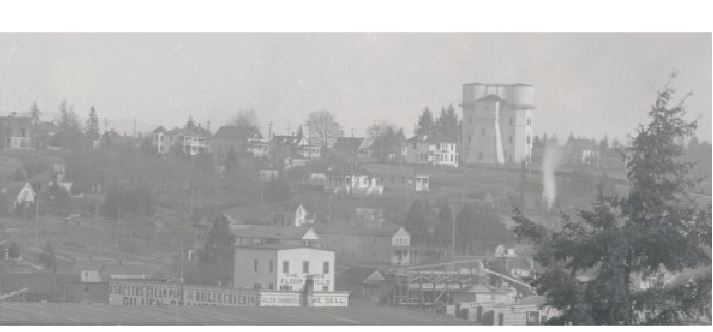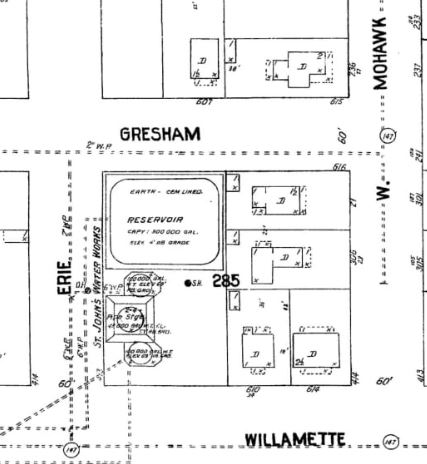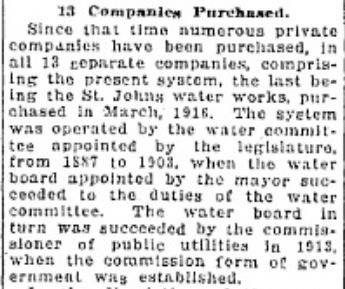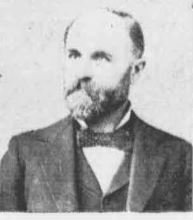 For every story there is a beginning. Originally the community of St Johns was confined to a small area near the banks of the Willamette river. In 1888 a new resident by the name of James Crittendon (Critt) Scott, of Scotch-Irish descent, secured a plot of land just below what we now refer to as the St Johns business district.
For every story there is a beginning. Originally the community of St Johns was confined to a small area near the banks of the Willamette river. In 1888 a new resident by the name of James Crittendon (Critt) Scott, of Scotch-Irish descent, secured a plot of land just below what we now refer to as the St Johns business district.
Scott bought land from P.T. Smith as well as John Mock and built a home below the Burlington St. hill. Scott was the first to build and make improvements immediately above the waterfront. The first it was said to have a home "on top of the hill". It was thought that Scott moved to St Johns because of its strong Adventist Church community.
Critt Scott found it inconvenient to bring water up from the river area by hand for his house and stock so he devised a pumping system for himself. He kept revising / improving this system over the years. It included a well, a steam driven pump, a series of wooden pipes, and a storage tank. Before long he was offering to pipe water to some neighbors. Some accounts list Scott's original well as being on land now occupied by the City Hall building. Other sources say that this location was the site of his storage tank.
Scott expanded his business several times, moving from one location to another if he found there was an advantage, but he didn't run his water business alone. Soon his son's Vern and Vinton were assigned to operate the steam engine which pumped the water into the storage tank. They used field glasses to determine the level in the tank, saving them trips up the hill. When electricity became available a larger tank was constructed on Willamette Blvd and an electric pump replaced the steam engine.
In using language of the day most everyone lived "under the hill" in the beginning. The area we now associate with the St Johns business district consisted of a "forest of mighty trees, traversed here and there by winding trails and crooked paths".
As a business Scott found it took quite a bit of effort to run the water works yet returned only a small profit for his efforts. Early on he was supplying water to just 20 customers, but even that was a challenge.
Scott hadn't anticipated in the beginning that the water business would consume so much of his time, nor that it would be 17 years before he could walk away from it. When St Johns became a city the city council allowed Scott to continue being it's sole water provider. Several other people from outside the area put in their pitch that they could do it better but the council felt a loyalty to Scott.
In time Scott did take on partners for capital improvements / management of the business. H. L Powers of Hartman, Thompson, and Powers secured a half interest in the water works around 1903. Between 1903 and 1905 Powers became the driving force for needed equipment upgrades and customer expansion. A large reservoir was added for reserve fire protection. "The outlay has been excessive - the income meager - but Mr. Powers was planning for the future".
In 1905 a connection was made from the St Johns Water Works to the pumping station of the Portland Woolen Mills to handle fire emergencies. Two of the wooden water towers that had been used in the 1905 Lewis and Clark Fair were moved after the fair closed to St Johns. The twin towers were installed on Willamette Blvd, joining a water tower that Scott already had in place.
As for the quality of the water one early settler is quoted as saying "The water was as hard as rocks, but it had a good taste." Part of that taste may have been imparted by the wooden pipes which the water flowed through. From St Johns: The Gateway to Portland Harbor (circa 1907) we learn "the city is supplied with pure water of a most excellent quality from wells one hundred and fifty feet deep, at the rate of $1.00 a month for residences, which is at least twenty-five cents less than the rate charged in the City of Portland and it's suburbs. Capacity: Reservoir, 360,000 gallons; tanks, 250,000 gallons; electric pump, 17,000 gallons and hour; steam pump, 50,000 gallons and hour; two seventy-five horse-power boilers, and twenty-eight fire hydrants, operated by a private corporation.
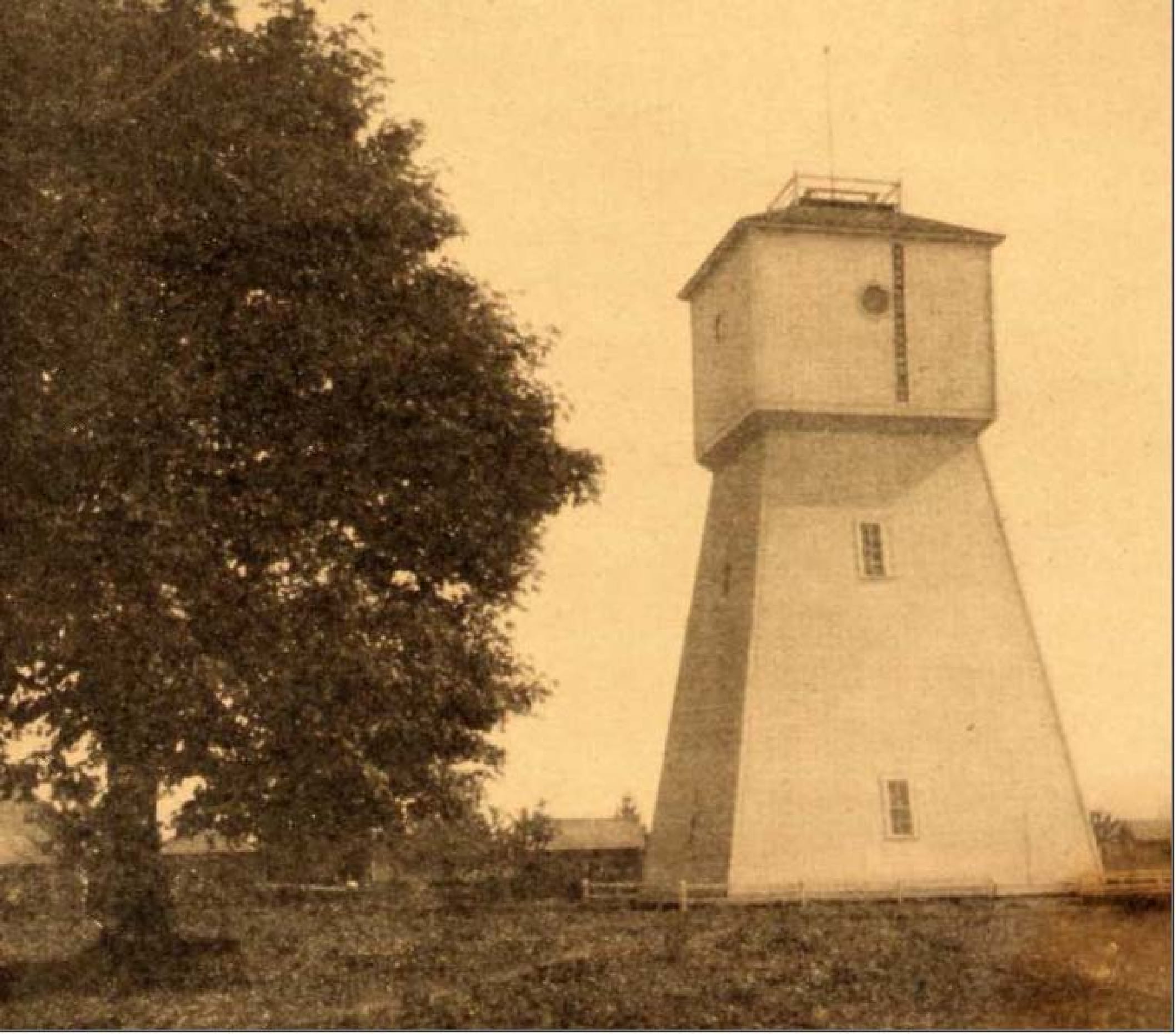 Willamette Blvd. near Mohawk Ave.1905
Willamette Blvd. near Mohawk Ave.1905
In December of 1905 Scott decided he needed a rest, so relinquished his interest in the business. T.H. Edlefson assumed the duties that had been Scott's. Edlefson had previous experience in the water business, which made for a smooth transition. Scott died almost a year later, in November of 1906 of typhoid fever. He was 55. Scott was buried in what is now known as the Columbian Cemetery. As a show of respect all business in St Johns was suspended the day of his funeral.
In addition to his years as owner, part-owner, and manager of the water works Scott had also been a board member of the first school board in district No. 2. He left behind his wife Louvisa and four surviving children. Critt and Louvisa had six children all together, but only four survived to adulthood. Scott had been a longtime member of the Adventist Church and a supporter of the Women's Christian Temperance Union.
Louvisa, after Critt's passing, donated 5 acres of land to the Adventist Church so that it could move up to the bluff from the river front according to her obituary. Another article says that it was Critt who had given a lot to the church from a five acre tract which he owned on Central Street. After his death Louvisa built a small house on the tract near the church. Her old house burned down soon after she moved to her new one.
Louvisa was a active campaigner against "demon rum". In 1905 she was elected president of the Women Christian Temperance Union of St. Johns, a position she held for 15 years. In June 1920 she was made their honorary president for life. Louvsia died on October 25, 1921 and was buried beside her husband. She was 65.
Scott, always civic minded, had gone before the Oregon Legislature, representing the St Johns community, to successfully petition for its city charter.
Scott had been born December 18, 1851 In Washington County, Indiana, the 10th of 11 children. The family first moved to Davis County, Iowa. Then in about 1870 Scott's father and several of the children moved to Saunders County, Nebraska.
Critt and Louvisa were married July 30, 1871 in Davis County, Iowa. They spent their first married year together in Davis County, then moved West by way of a prairie schooner. They arrived in Saunders County, Nebraska on October 1st 1872. There they filed for a homestead and built a sod-house. While still in the sod-house they had their first child, a son. In October of 1874 the moved into a more comfortable wood frame house. Small as it was it the move was quite an event as only one or two other frame houses were within a circle of 15 miles. After five years they received the deed to their land and traded it for a larger place two miles away.
In 1879 Critt and Louvisa were "converted" and joined the Seventh-Day Adventist Church. On Christmas day in 1887 they sold the old homestead for $4,000 and on May 24th, 1888 arrived in St. Johns. He wasted no time in settling in to his new surroundings.
As you read through the various articles you can see that it was a constant struggle to provide the capacity and the water pressure needed for a growing St Johns. One important consideration was to have enough pressure and water access locations (fire hydrants) to battle fires. Once they had the water available they formed a volunteer fire department.
Unanswered questions: Who was W.A Willison? When did the Water Works become the Water Works and Lighting Company?
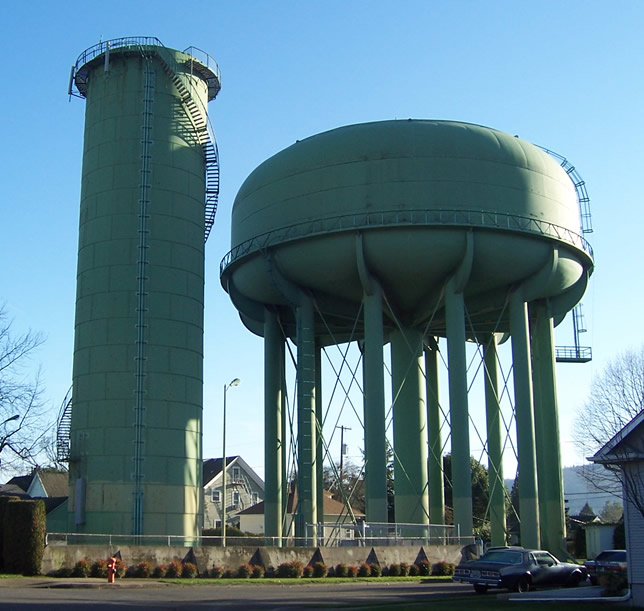 The tower on the left is known as the Vernon Standpipe. It replaced the three wooden water tanks, two of which had been salvaged from the 1905 Lewis & Clark Exposition. At one time this single column tower stored water for all of St. Johns. Today it is joined by two much larger larger tanks, one of which is seen here. The St Johns Water works originally had a small reservoir in addition to the wooden storage tanks. A portion of the reservoir retaining wall remains and is visible in this photo taken at Oswego Ave. and Princeton St.
The tower on the left is known as the Vernon Standpipe. It replaced the three wooden water tanks, two of which had been salvaged from the 1905 Lewis & Clark Exposition. At one time this single column tower stored water for all of St. Johns. Today it is joined by two much larger larger tanks, one of which is seen here. The St Johns Water works originally had a small reservoir in addition to the wooden storage tanks. A portion of the reservoir retaining wall remains and is visible in this photo taken at Oswego Ave. and Princeton St.
Information on the St Johns Water Works was compiled by Jim Swart and Gil Parton
Learn more about St Johns Water Works
♦ ♦ ♦
Learn more about the Vernon Standpipe
~ Navigation Hint ~
Those of you who use a mouse press the Control key and move the thumb wheel at the same time. This will allow you to increase or decrease the size of the photo / article.
To return to the normal screen size press the Control key and the number "0" (zero).
Daniel Starr Southmayd
An earlier settler of St Johns, Daniel Starr Southmayd (1825-1861), had a 640 acres land claim further to the North above the bluff. An 1852 township survey map shows his property as the only cultivated land in the St Johns area at the time. Southmayd's home was located near the present site of The Union at St Johns. The house design copied lodges build by Columbia River Native Americans, with half above ground and half below. As a minister, Southmayd was a trustee of the Methodist-Episcopal Church - St Johns' first church. The church was built from scrap lumber at the northwest corner of Richmond and Bradford. Southmayd made his living as a printer, setting type for the Oregonian when it was published out of a little shack on Stark Street.
We will expand on the life of David Star Southmayd in a future story about early St Johns pioneers.

